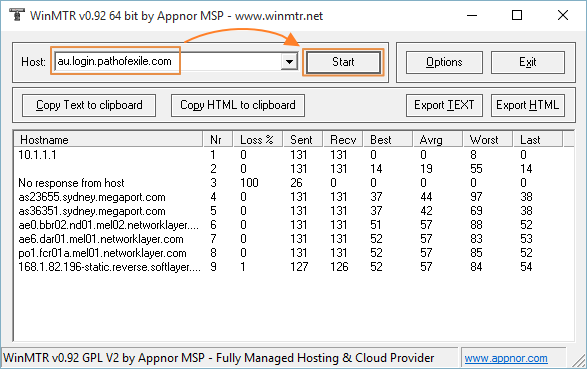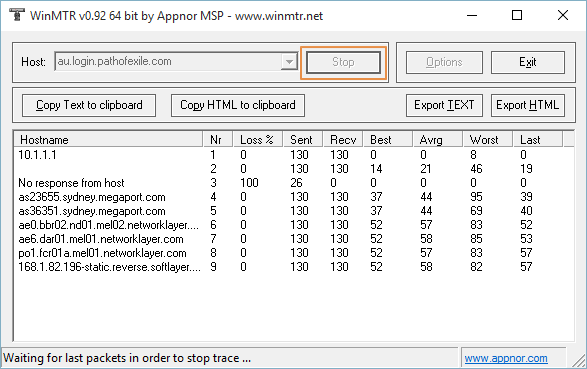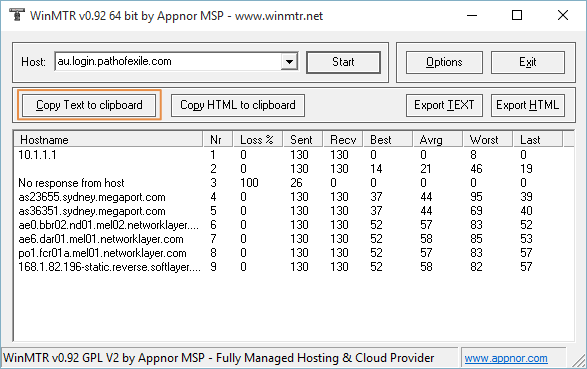MTR and Connectivity Issue Primer
We prefer to use WinMTR to troubleshoot general network connectivity when using Windows platforms. It's open source and free to use.
Please use the below link:
Download WinMTR here.
_______________________________________________
Testing your connection
1) Obtain an IP address/URL to test:
- Instance Servers
- In-game, enter the problematic instance with your character
- Open your client logs (located at "C:\Program Files (x86)\Grinding Gear Games\Path of Exile\logs\Client.txt" by default)
- Find the last entry for "Connecting to instance server at <IP ADDRESS>:<PORT>" and grab the IP address:

- Patching Servers
If you are diagnosing your connection to the patching server, please use 'patchcdn.pathofexile.com'
2) Enter the IP address/URL into the Host box and Start:
 3) Allow the trace to run for a few minutes (around 300-500 packets) and Stop:
3) Allow the trace to run for a few minutes (around 300-500 packets) and Stop:
 4) Copy Text to clipboard:
4) Copy Text to clipboard:
 5) Either-
5) Either-
- [Preferred] Paste the output into pastebin.com, and place the link in your thread.
- [Harder to read] Paste directly into your post.
_______________________________________________
Common WinMTR Issues
- All hosts on the route report no response.
Make sure you're running a recent version of WinMTR (>0.92). If you still experience this, run WinMTR as administrator.
- No response from a single host.
Having no response from a single host in the middle of your route (100% packet loss) is often normal. Some routers do not respond to the ICMP protocol that WinMTR uses.
- One or more hops show packet loss. Is this real packet loss?
It can be often hard to tell if the packet loss you see in a WinMTR trace is real.
Many routers on the internet employ ICMP deprioritization; dropping ICMP packets in order to guarantee resources to more important traffic. If the packet loss does not continue through to the remaining hops in your route, the loss can most likely be attributed to deprioritization.
If the packet loss continues through to the end of your trace, the packet loss has a good chance of being genuine, and may be contributing to poor game performance.
_______________________________________________
Common causes of network connectivity issues
Wireless networks:
Characterised by-
- Packet loss before/at your home router
- High latency before/at your home router
- Network drops (drops in internet connectivity)
- Jitter
One of the most common causes of connection issues is wireless networking. There are a great many factors that can cause it to perform sub-optimally. These include, but aren't limited to, RF spectrum congestion, 2.4GHz devices, walls and obstructions, general interference and faulty hardware. A sound way to eliminate this as a cause is to test your connection while plugged into your router with an Ethernet cable.
Faulty network hardware:
Characterised by-
- Packet loss before/at your home router
- High latency persisting through your route
- Network drops (drops in internet connectivity)
Faulty network hardware such as a faulty switch, router, or damaged Ethernet cable can be at fault here. Try swapping them out.
Problems caused by your ISP:
Characterised by-
- Packet loss and latency jumps early in your route, but after your home router.
- Weird and unusual routing (e.g. routing to a different location and returning)
This can cause bad behaviour at the first couple hops in your trace. If the issue persists, we recommend contacting your ISP.
Problems caused by upstream/downstream providers:
Characterised by-
- Packet loss in the middle of a trace, before traffic reaches Network Layer
- Sudden jumps in latency in the middle of a trace
- Weird and unusual routing (e.g. routing to a different location and returning)
This type of issue can be difficult to track down and solve if the symptoms don't resolve themselves. We have no direct path to escalate issues if they're being caused by upstream providers (e.g. Level3, AT&T, Verizon). If the problem is affecting a large amount of players, we can escalate to our server provider, to see if they can do anything such as route around the issue, but often they will refer us back to having the specific users contact their ISP for further assistance.
A useful website that may show if there are backbone issues is the Internet Health Report (http://internetpulse.keynote.com/)
Problems caused by our provider:
Characterised by-
- Packet loss or latency jumps at Network Layer routers, persisting through to the server at the end of the trace.
If we determine the issue is being caused by our provider, we will escallate directly to them, have them solve the issue and provide updates as soon as possible. If there are problems with Network Layer, they will be affecting all players connecting to the gateway having trouble.
Temporary internet backbone re-routing:
Characterised by-
- Weird and unusual routing (e.g. routing to a different location and returning)
- High latency due to the above
Occasionally, upstream providers will update their routes in order avoid hardware that is experiencing issues. Not much can be done in this situation, but usually the normal routing is restored relatively quickly.
_______________________________________________
Frequently asked questions
If you are using Lockstep Mode-
- Due to its nature, Lockstep Mode is more sensitive to the quality of your connection to our servers. Because of this, we only recommend its use if you have stable connectivity and low latency to your realm's servers. If your connection is having issues, it will be a lot easier to notice when you are running Lockstep. If you are experiencing issues, it might be a good idea to change to Predictive Mode to see if they are lessened. With the implementation of Lockstep Mode, there have been a great number of improvement to Predictive that should make the experience superior to Predictive pre-2.0.
Everyone seems to be having the same issue as me. Is there a greater problem going on?
- Maybe, but maybe not. Internet issues tend to cause very similar symptoms, but have a wide range of varying root causes.Players reporting similar problems can often be from different regions, different providers or not be connecting to the same servers as you are.
I seem to be experiencing lag since the latest patch. Is it the patch causing my problem?
- Probably not. It is very rare that we make changes to the game that affect the network stack. It's more likely that something else has changed, coinciding with timing of the patch.
I have a fast connection, with great upstream and downstream bandwidth. Shouldn't I be free from lag?
- Not necessarily. The amount of bandwidth utilised by Path of Exile is relatively small. Other characteristics such as latency and jitter are going to be more important to your overall experience. This is especially true when utilising Lockstep mode.
I don't experience any lag in other games, only Path of Exile. Why is this?
- There are a variety of factors that can cause this. The route that your connection takes to reach our servers may be significantly different than that to the servers for other online games. Internet issues that affect us, may not affect them and vice-a-versa.
Speedtest.net shows no packet loss. Shouldn't this indicate I am problem free?
- Speedtest.net is not a good indicator as to the quality of your internet connection. While it is good for gauging general download speeds, it is not good for testing packet loss and latency to ranges of remote servers. The default behaviour is to select a server as geographically close to you as possible.
Are my region's servers slower than others?
- No. Our instance servers utilise identical hardware specifications in all regions.















